|
Author
|
Topic: [Discuss] Lunar Reconnaissance Orbiter
|
Robert Pearlman
Editor Posts: 50476
From: Houston, TX
Registered: Nov 1999
|
 posted 12-23-2004 07:30 AM
posted 12-23-2004 07:30 AM
   
This thread is intended for comments and questions regarding the Lunar Reconnaissance Orbiter (LRO) and the updates published under the topic: NASA's Lunar Reconnaissance Orbiter (LRO). |
mensax
Member Posts: 861
From: Virginia
Registered: Apr 2002
|
 posted 12-23-2004 07:48 AM
posted 12-23-2004 07:48 AM
   
We will definitely be able to spot the LM descent stages and Rovers This is tremendous! I can't wait! |
Spacepsycho
Member Posts: 901
From: Huntington Beach, Calif.
Registered: Aug 2004
|
 posted 12-23-2004 12:07 PM
posted 12-23-2004 12:07 PM
   
I can't wait to see the first photos of the descent modules and lunar rovers left behind. |
NC Apollo Fan
Member Posts: 261
From: Belmont, NC USA
Registered: Jul 2000
|
 posted 12-23-2004 03:24 PM
posted 12-23-2004 03:24 PM
   
I wonder if they might image the intentionally crashed ascent modules (and if there would be anything at all left to see). |
micropooz
Member Posts: 1679
From: Washington, DC, USA
Registered: Apr 2003
|
 posted 12-23-2004 05:05 PM
posted 12-23-2004 05:05 PM
   
And to add to the post above, some of the SIVB stages were crashed into the moon in order to produce seismic waves for the seismometers that were left on previous missions. Imaging the craters they left (doubtful that any discernable hardware left) could tell the geologists some information on crater size vs. energy and density of the impacting object. |
tegwilym
Member Posts: 2339
From: Sturgeon Bay, WI
Registered: Jan 2000
|
 posted 06-19-2009 11:41 AM
posted 06-19-2009 11:41 AM
   
I thought it was interesting how slowly it looks like this thing climbed off he pad. Compared with the shuttle it looks like it took it's time accelerating. The shuttle doesn't mess around, it just gets up and goes! |
DChudwin
Member Posts: 1121
From: Lincolnshire IL USA
Registered: Aug 2000
|
 posted 06-21-2009 09:15 AM
posted 06-21-2009 09:15 AM
   
An excellent blog with status reports and other information about LRO: This blog follows the progress of the LRO mission through Integration and Testing at NASA's Goddard Space Flight Center and launch site processing at KSC\Astrotech. Its purpose is to enable communication to the entire LRO Team about the status of ongoing activities.LRO was launched June 18th, 2009 at 5:32pm EDT from KSC. This BLOG will follow the progress of the mission as LRO travels to the moon and establishes orbit around it. |
Lasv3
Member Posts: 459
From: Bratislava, Slovakia
Registered: Apr 2009
|
 posted 06-24-2009 10:10 AM
posted 06-24-2009 10:10 AM
   
Just for the sake of clarity, can somebody tell me where are the public's names stored on the spacecraft? Is it LCROSS or is it LRO? I'm asking as my grandson and myself are on board and I'd like to know what and when we have to expect. Are we going to crash the South Pole in October with LCROSS or do we stay longer with the LRO? |
Robert Pearlman
Editor Posts: 50476
From: Houston, TX
Registered: Nov 1999
|
 posted 06-24-2009 11:05 AM
posted 06-24-2009 11:05 AM
   
The 1.6 million names are held on a microchip encased in a radiation hardened container and attached to the back of LRO's propulsion module access panel. 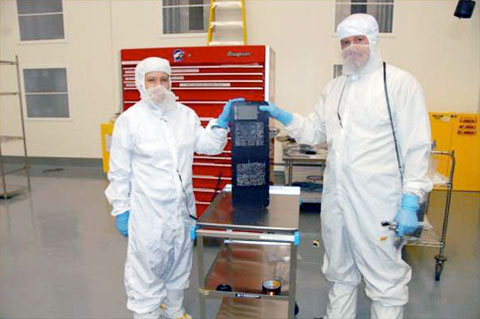 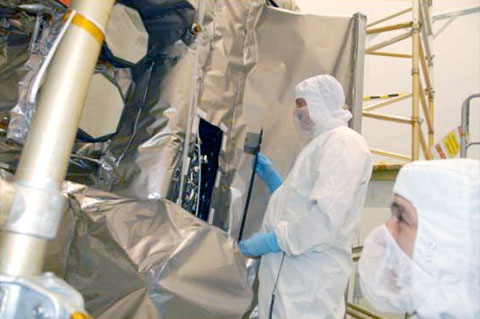
|
rodpyle
Member Posts: 23
From: Pasadena, California, USA
Registered: Dec 2008
|
 posted 07-02-2009 01:19 PM
posted 07-02-2009 01:19 PM
   
Those are some stunning photos. And my favorite time of "day" as well! Are there plans to snap the Apollo sites? Do you know which ones? And what level of magnification? |
Robert Pearlman
Editor Posts: 50476
From: Houston, TX
Registered: Nov 1999
|
 posted 07-02-2009 01:24 PM
posted 07-02-2009 01:24 PM
   
There are plans, though which site will be first and when it and the others are imaged will rely on several factors. We are evaluating the possibility of obtaining images of the Apollo sites before we reach our primary 50-kilometer mapping orbit. The ability to image Apollo sites depends on the satellite ground track and lighting conditions. If conditions are favorable and an image is made, it will promptly be released to the public. |
ejectr
Member Posts: 1961
From: Killingly, CT
Registered: Mar 2002
|
 posted 07-02-2009 02:23 PM
posted 07-02-2009 02:23 PM
   
These images show cratered regions near the moon's Mare Nubium region, as photographed by the Lunar Reconnaissance Orbiter's LROC instrument. Each image shows a region 1,400 meters (0.87 miles) wide. the bottoms of both images face lunar north. WOW!!! I remember sitting in front of my parents' B&W TV watching the first Ranger photos come in.Needless to say, we've come a long way, baby! |
medaris
Member Posts: 185
From: United Kingdom
Registered: Mar 2007
|
 posted 07-02-2009 06:45 PM
posted 07-02-2009 06:45 PM
   
These are stunning pictures. It's great to see more photos from the moon. I'll be excited to see Apollo site photos — but I'll be even more excited to see where we haven't been. I'm looking forward to the next lunar landings. |
tegwilym
Member Posts: 2339
From: Sturgeon Bay, WI
Registered: Jan 2000
|
 posted 07-06-2009 05:09 PM
posted 07-06-2009 05:09 PM
   
Has anyone seen when we might see the Apollo sites? I haven't noticed anything other than it should be "soon". I'm pretty excited to see that stuff! |
Robert Pearlman
Editor Posts: 50476
From: Houston, TX
Registered: Nov 1999
|
 posted 07-06-2009 05:24 PM
posted 07-06-2009 05:24 PM
   
My understanding is that there will be no pre-announcement; "soon" is the best they can provide. If the opportunity presents itself, they will image one or more of the Apollo sites as they fly over during this commissioning phase and release the images as they are received. Otherwise, they will wait until LRO drops into its lower orbit. If images do come during the commissioning phase, we may still need to wait until the mapping orbit to make out the finer details of the landing sites. |
spaced out
Member Posts: 3190
From: Paris, France
Registered: Aug 2003
|
 posted 07-07-2009 01:55 AM
posted 07-07-2009 01:55 AM
   
As I understand it the resolution on the high flyby would be 100cm/pixel versus 50cm/pixel in the final low orbit.In the low orbit that would mean an LM descent stage would show up about 9 pixels across (excluding landing gear) and a lunar rover would be about 6 pixels long. At that resolution it's certain that some other equipment will be large enough to show up. Otherwise it will be the disturbed surface that will show up around the sites, including the tracks of the astronauts, the LRVs and the Apollo 14 MET. Of course a low sun will mean items on the surface casting long and very easy-to-spot shadows so I think some of the most striking images will be taken in those conditions. That means waiting for a good combination of fly-over and sun cycle at each site. The first images from each site, even in low orbit, won't necessarily be the best. One detail that should be interesting: if the material of any of the flags is intact the shadow from this might well be visible at 50cm/pixel. |
ilbasso
Member Posts: 1527
From: Greensboro, NC USA
Registered: Feb 2006
|
 posted 07-16-2009 03:46 PM
posted 07-16-2009 03:46 PM
   
quote:
Originally posted by tegwilym:
Has anyone seen when we might see the Apollo sites?
NASA release NASA Briefs Media on New Images of Apollo Lunar Landing SitesNASA's Lunar Reconnaissance Orbiter, or LRO, has sent back its first images of Apollo lunar landing sites. The agency will release the images Friday, July 17, at noon and hold a teleconference at 2 p.m. EDT to discuss the photos and future plans for the LRO mission. Participating in the teleconference are: - Michael Wargo, chief lunar scientist, NASA Headquarters, Washington
- Richard Vondrak, project scientist, Lunar Reconnaissance Orbiter, NASA's Goddard Space Flight Center, Greenbelt, Md.
- Mark Robinson, principal investigator, Lunar Reconnaissance Orbiter Camera, Arizona State University
|
spaced out
Member Posts: 3190
From: Paris, France
Registered: Aug 2003
|
 posted 07-17-2009 04:19 AM
posted 07-17-2009 04:19 AM
   
Should be interesting. Remember that these images will be at about half the resolution we can expect when the orbiter reaches its final altitude.At 100cm/px you can expect the LM descent stage body to be about 4 or 5 pixels across, and an LRV to be maybe 3 pixels long. Not enormous, but low angle sunlight could throw out long shadows that would make objects stand out very clearly, even at that resolution. Then there's the disturbed surface soil around the sites which could show up quite distinctly over a large area depending on lighting conditions. Anyway, I'll stop speculating now and wait to see the actual images... |
Scott
Member Posts: 3337
From: Houston, TX
Registered: May 2001
|
 posted 07-17-2009 08:09 AM
posted 07-17-2009 08:09 AM
   
This is so cool. I know I'm not the only one who has hoped for this moment for years. |
ilbasso
Member Posts: 1527
From: Greensboro, NC USA
Registered: Feb 2006
|
 posted 07-17-2009 11:33 AM
posted 07-17-2009 11:33 AM
   
Great photos of every landing site except Apollo 12. You can even see the MET tracks for Apollo 14! |
MrSpace86
Member Posts: 1618
From: Gardner, KS
Registered: Feb 2003
|
 posted 07-17-2009 11:56 AM
posted 07-17-2009 11:56 AM
   
Those are really nice. I tried looking for the HQ versions of these photos on their website and could not find them. Will they be posted soon? |
Robert Pearlman
Editor Posts: 50476
From: Houston, TX
Registered: Nov 1999
|
 posted 07-17-2009 12:00 PM
posted 07-17-2009 12:00 PM
   
I believe these are the highest resolution available; they appear to be crops (if not also enlargements) from photos taken of the larger surrounding areas on the Moon.On edit: You can zoom in on these images via the LRO Camera (LROC) website. |
mmmoo
Member Posts: 577
From: London, England
Registered: May 2001
|
 posted 07-17-2009 12:02 PM
posted 07-17-2009 12:02 PM
   
Wow! The Apollo 14 shot is fantastic!I may be wrong but I think the Apollo 14 shot shows Doublet Craters at the top left, and Triplet Craters at the bottom right. I have laid the image over the Apollo 14 Traverse map, and it matches the craters, the LM, and the ALSEP. 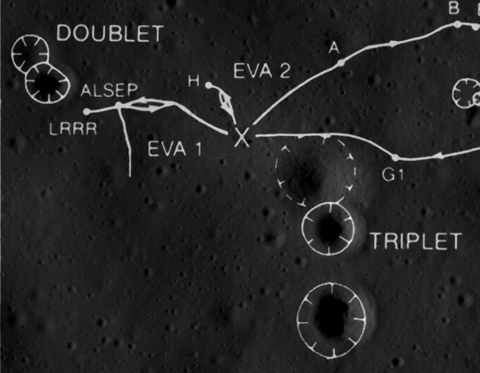 |
FFrench
Member Posts: 3288
From: San Diego
Registered: Feb 2002
|
 posted 07-17-2009 12:08 PM
posted 07-17-2009 12:08 PM
  
Interesting to compare the Apollo 15 one with this 1971 photo which NASA lists as taken during the Apollo 15 mission from Endeavour about four hours after Falcon landed on the surface.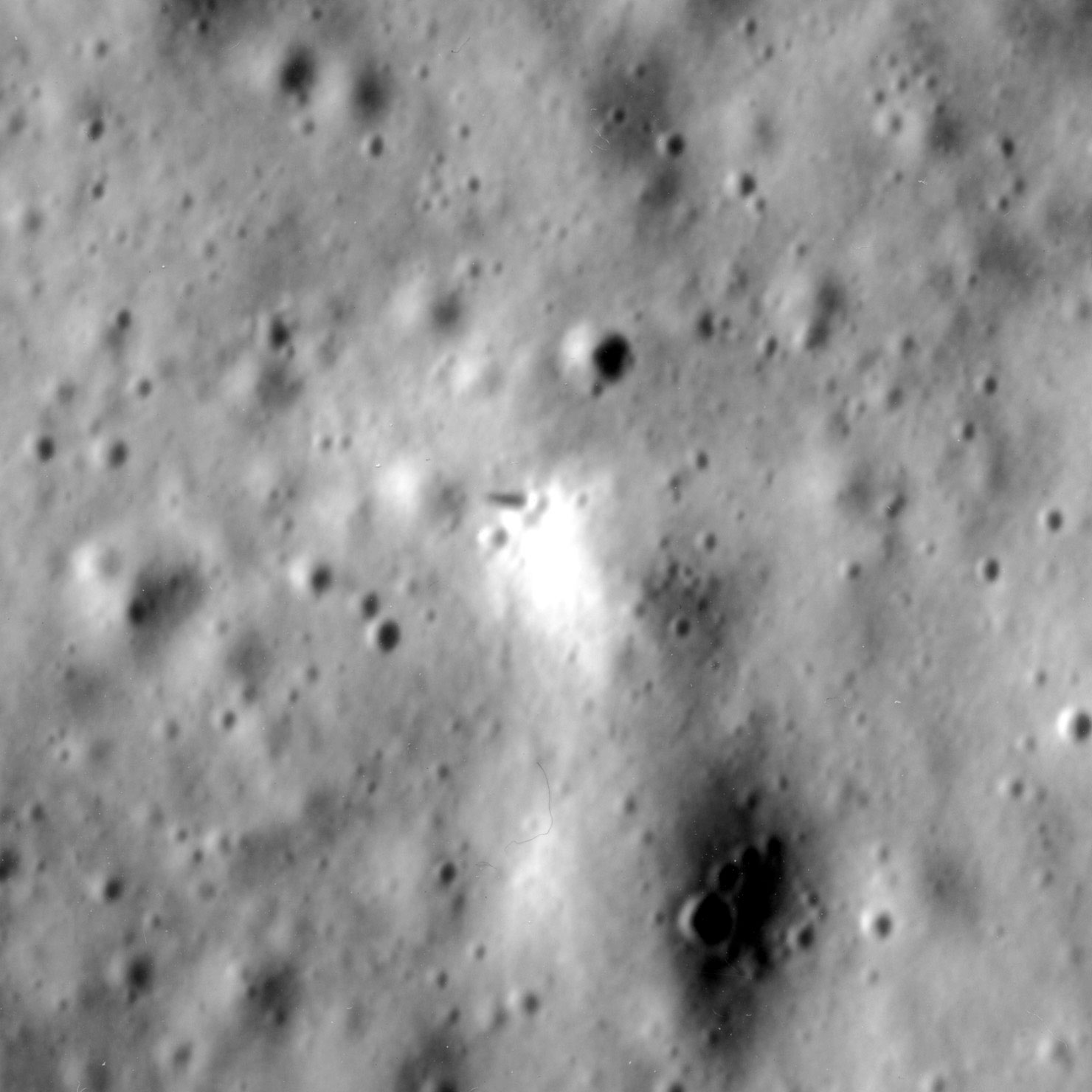 |
ilbasso
Member Posts: 1527
From: Greensboro, NC USA
Registered: Feb 2006
|
 posted 07-17-2009 12:36 PM
posted 07-17-2009 12:36 PM
   
Unmannedspaceflight.com has an interesting analysis of the photos from some folks who are experts in interplanetary image processing. |
Robert Pearlman
Editor Posts: 50476
From: Houston, TX
Registered: Nov 1999
|
 posted 07-17-2009 01:30 PM
posted 07-17-2009 01:30 PM
   
quote:
Originally posted by mmmoo:
I may be wrong but I think the Apollo 14 shot shows Doublet Craters at the top left, and Triplet Craters at the bottom right.
During the press teleconference, Mark Robinson said that Cone Crater was east of Antares, out of view in the image, so it looks like you were correct. |
Blackarrow
Member Posts: 3602
From: Belfast, United Kingdom
Registered: Feb 2002
|
 posted 07-17-2009 03:26 PM
posted 07-17-2009 03:26 PM
  
This is wonderful! Fittingly, I think the Apollo 11 view is the best, clearly showing (in the full frame shot) West Crater and its boulder field, and the smaller crater which Armstrong visited. It's all there!The Apollo 16 picture clearly shows the crater which "Orion" nearly landed in. The shadow of the LM crosses the crater shadow. The Apollo 17 picture shows the shadow of "Challenger" but look to the left (i.e. west of the LM's position) and you can see a shadow of similar size. If you check the pictures taken by the crew looking forwards out of the LM windows, you will see a large boulder, comparable in size to the LM descent stage. But the boulder isn't flat-topped, so its shadow tapers. It's important to note that all of these images must have been taken as the sun was SETTING so the shadows go from right to left. |
ejectr
Member Posts: 1961
From: Killingly, CT
Registered: Mar 2002
|
 posted 07-17-2009 04:23 PM
posted 07-17-2009 04:23 PM
   
Look at the Apollo 16 photo. You can see the shadow of the LM on the edge of the crater to its right! |
Mike Z
Member Posts: 451
From: Ellicott City, Maryland
Registered: Dec 2005
|
 posted 07-17-2009 06:20 PM
posted 07-17-2009 06:20 PM
   
WOW!! These are truly EXCITING images!! It's AMAZING that these sites have not been seen since each crew lifted off of the moon! |
Robert Pearlman
Editor Posts: 50476
From: Houston, TX
Registered: Nov 1999
|
 posted 07-17-2009 07:17 PM
posted 07-17-2009 07:17 PM
   
If memory serves correctly, the exact landing coordinates for Eagle on Apollo 11 were never really known, but were estimated based on the surface photography. Can we now tell how close those estimates got? |
Machodoc
Member Posts: 209
From: Bryn Mawr PA
Registered: Aug 2005
|
 posted 07-17-2009 11:52 PM
posted 07-17-2009 11:52 PM
   
I'm just amazed and regard them as a birthday present to the anniversary of Apollo 11. |
mjanovec
Member Posts: 3811
From: Midwest, USA
Registered: Jul 2005
|
 posted 07-18-2009 12:19 AM
posted 07-18-2009 12:19 AM
   
Are there other images of Apollo 15, 16, and 17 that show the extent of the lunar rover tracks? If the tracks left by Apollo 14 astronauts are clearly visible, I would think the rover tracks left by the J series missions should also be visible...at least in places where the rover doubled back on itself. And, of course, it would be nice to see images that include the rovers themselves!I can't wait to see what the higher resolution pictures on later passes reveal. |
spaced out
Member Posts: 3190
From: Paris, France
Registered: Aug 2003
|
 posted 07-18-2009 03:08 AM
posted 07-18-2009 03:08 AM
   
quote:
Originally posted by mjanovec:
And, of course, it would be nice to see images that include the rovers themselves!
Post#32 on the UnmannedSpaceflight thread shows the three rovers in the images.
|
spaced out
Member Posts: 3190
From: Paris, France
Registered: Aug 2003
|
 posted 07-18-2009 03:32 AM
posted 07-18-2009 03:32 AM
   
quote:
Originally posted by Robert Pearlman:
If memory serves correctly, the exact landing coordinates for Eagle on Apollo 11 were never really known, but were estimated based on the surface photography. Can we now tell how close those estimates got?
Since the layout and detail of the craters is pretty unique, and they had good images of the area taken on descent and ascent phases I think there was never really any doubt as to the location once they had time to analyze all the imagery. Shortly before the LEM lifted off NASA's best-guess estimated position on the surface was already within a couple of hundred yards of the actual location.Here's an extract from an Apollo 11 traverse map from the ALSJ. 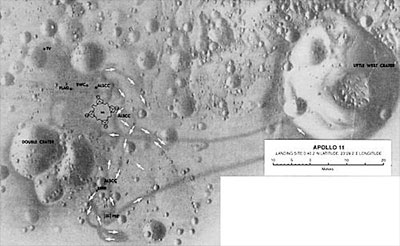 And here's the same area from the LRO image: 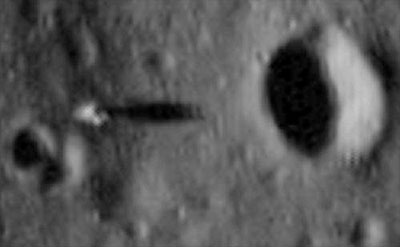 The location of Eagle is basically spot-on. Incidentally, for those of you trying to interpret the landing site images I strongly recommend that you look up the traverse maps for each mission on the Apollo Lunar Surface Journal. |
ilbasso
Member Posts: 1527
From: Greensboro, NC USA
Registered: Feb 2006
|
 posted 07-18-2009 07:19 AM
posted 07-18-2009 07:19 AM
   
Seeing these images makes me wonder anew how our guys ever found their way around on the ground. That to me was one of the biggest surprises of the EVAs - that the astronauts were able to navigate at all in this undulating, vast expanse of nothingness, with maybe one or two landmarks if they were lucky. Had Shepard and Mitchell not been so spot-on in their landing (they were the closest to the targeted point of any of the Apollo landings), I really wonder if they would have been able to find their way as well as they did - and even so, not being able to find the rim of Cone Crater. The J missions could at least triangulate their positions from some pretty spectacular landmarks, and Apollo 12 had the Surveyor. But the Apollo 14 crew was really on their own when they trekked so far away from the LM! Take a look back through the photo archive and you'll see how rolling the ground was. Simply amazing. |
Brian Bayley
Member Posts: 32
From: Merseyside UK
Registered: Nov 2004
|
 posted 07-18-2009 12:21 PM
posted 07-18-2009 12:21 PM
  
If I'm not mistaken, the technology required to get a skyscraper into orbit is equal if not greater than that required for the rest of a moonlanding mission. The launches were witnessed. The hoaxers seem to overlook this point. Fantastic images. I can't wait for the lower order images. |
Paul Littler
Member Posts: 70
From: Brentwood, Essex, UK
Registered: Jul 2003
|
 posted 07-18-2009 02:04 PM
posted 07-18-2009 02:04 PM
   
I am really happy to see these pictures of the LM at the landing sites and cannot wait to see the mission fully under way when LRO leaves the commissioning orbit.Does NASA know where the the S-IVB's that hit the moon are? There may be some spectacular man made craters for LRO to find. |
Blackarrow
Member Posts: 3602
From: Belfast, United Kingdom
Registered: Feb 2002
|
 posted 07-18-2009 02:11 PM
posted 07-18-2009 02:11 PM
  
The "Apollo 16 Preliminary Science Report" contains a series of photos taken from lunar orbit showing the impact craters left by Rangers 7, 8 and 9; the Apollo 13 S-IVB; the Apollo 14 S-IVB; and the Apollo 14 LM ascent stage. |
ilbasso
Member Posts: 1527
From: Greensboro, NC USA
Registered: Feb 2006
|
 posted 07-18-2009 08:53 PM
posted 07-18-2009 08:53 PM
   
As of mid-June, this interactive map has the prioritized list of LRO targets. (You can add a request to include a site!!) They're also in Excel format here. Fascinating to see what they chose and why. |
Klaatu
Member Posts: 60
From: England
Registered: Sep 2007
|
 posted 07-19-2009 10:38 AM
posted 07-19-2009 10:38 AM
  
Well, we've all been waiting for these images for years... and they're finally here. Wonderful stuff! I can't wait to see the higher res images when the LRO is in it's lower orbit. |

















